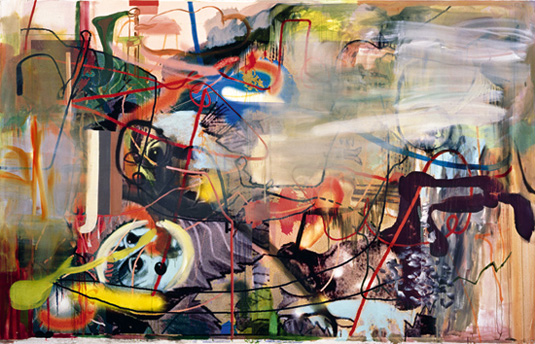| Albert Oehlen |
|
Yvonne Zieger Albert Oehlen: Painting against the Nice GuysAlbert Oehlen is one of those artists who scrutinize their environment with an observant, sociocritical eye, and undistortedly reflect what they see. In the 1980s, he literally hurled the dirt of art-internal clichés, fossilized shows, desolate middle-class conventions and undigested German history onto his canvasses. Yet there are also recurrent instances of self-critical references regarding the reception of the ego of an artist in self-portraits. Selbstportrait beim Töpfern (Self-portrait while Potting) (1986) shows the artist in a simplified room with a distorted perspective. Here, Oehlen portrays himself as a craftsman sitting on a bench making pottery. This is especially emphasized through the fixed gaze of the left eye, which is not only lighter and turned more towards the viewer than the right one, but also corresponds in color to the blue shirt, thus enhancing the luminosity and intensity of the portrait. The surroundings are austere like most of Oehlen’s painted interiors: a room with wooden paneling, which reminds one of a barred cage — a place where the artist and what he does are exhibited. All the composition lines converge with the bench in the middle of the picture where the figure of the artist is located at the center of it all. Creative work is depicted as the act of a craftsman, just as the audience likes it. Two years previously, in Selbstportrait mit verschissener Unterhose und blauer Mauritius (Self-portrait with shitty underpants and Blue Mauritius) (1984), Oehlen made his first radical break with the notion of the romantic artistic genius and its compensatory function for the middle classes. In the 1980s, Oehlen’s works were characterized by ‘polluting’ painting — its resources, painting techniques, and subjects — whereas his recent, more abstract works reflect the digital meanderings and opacity of contemporary everyday life. Since the beginning of the 1990s, Oehlen overlays image components that are concrete — painted or digitally printed — with lines, rough brushstrokes, blobs and smears until no realistic representation is recognizable anymore. Oehlen calls this “post-non-representational” art. If one assesses his oeuvre by the most recent works, apart from social critique and any anti-artistic impetus, a further feature emerges: the special treatment of the image space. In 1982, Oehlen created the large-format painting Flur (Corridor). On an abstract background of rough gray, white and red brushstrokes, black lines trace the outlines of floorboards. At the end of the corridor, a door can be seen leading to another room and, on the righthand side, the passageway appears bordered by a kind of recess or aperture, which tapers the room’s perspective towards the back together with the ceiling and door. Over the abstract background and the corridor depicted in perspective — in which the floorboards already break out of the composition — a further structure of lines is located on the uppermost level of the picture, which does not correspond with the other lines. White lines connect the contours of square mirrors, which are glued to the canvas and partially painted over. Flur is part of a series of works featuring mirrors, which were created in 1982 and 1983. [...] Catalog excerpt "Extended. Sammlung Landesbank Baden-Württemberg" Editors: Lutz Casper, Gregor Jansen, published by Kehrer Verlag Heidelberg, 2009 ^
|

